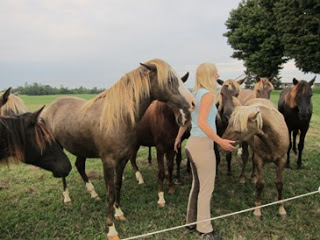
Jag har blivit alldeles för ”skadad” av min utbildning. (Jag är civilingenjör i kemisk biologi, specialisering genomik och proteomik). Vilket lett till att jag på många sätt söker genetisk variation. Även om man så klart inte får tappa all rastypiskhet – det enklaste sättet att få stor variation är ju att korsa med någon avlägset besläktad ras.
Det min utbildning har givit mig är en skepsis mot individer med för hög frekvens av samma individer, särskilt om de är nära i stamtavlan. Eftersom Rocky Mountain ras registret är så nytt (1986) och så stark präglad på Tobe och hans fem söner återkommer de ofta och hos många individer. Därför letar jag ständigt efter lite ovanligare linjer; efter de individer som har en lite annan bakgrund. Dels finns det “grade horses” dvs, hästar som tagits in i stamboken på grund av sina egenskaper, gångart och temperament då dessa uppfyller raskriterierna och så finns det vissa linjer som är mycket mindre använda. Jag har bl.a. skrivit ett inlägg om olika stammar tidigare på bloggen:
http://ullekalv.blogspot.se/2012/09/tobe-hans-soner-och-andra-hastar-som.html
Ytterligare ett sätt att få större genetisk variation är att välja individer av olika färger, olika typer och med olika rörelsemönster. Dessa olika typer tyder ändå på att de har fått lite olika genuppsättning av sina respektive föräldrar.

Att jag vill ha variation har inte heller något att göra med att jag inte gillar någon eller några specifika individer inom rasen, det handlar , enligt mig, enbart om att ALLA organismer bär på mindre önskvärda gener. Vissa har flera bra gener än andra (och dessa är de vi bör använda i aveln). Avkommorna kommer att få en blandning av både bra och dåliga egenskaper. Många “sämre” gener som kanske ger sjukdomar ger ofta inte upphov till problem förrän man får dem i dubbel upplaga – de är recessiva. Därmed får de flesta bärare inga problem och man märker heller inte av dem. men, om en individ har samma häst många gånger i sin stam ökar chansen att den får två kopior av de dåliga generna och därmed blir påverkad/sjuk. Men för att behålla typ och egenskaper får man så klart inte heller gå för långt bort släktmässigt. En balansgång som inte alltid är lätt.
Horse breeding – genetic variation
I guess my education has ”damaged” me in some ways; I search for genetic variation. (I have a degree in Engineering with biochemistry, especially genomics and proteomics) Even if you don’t want to lose too much breed character. The easiest way to get a broad variation would be to cross breeds that are far from each other.
 What my education taught me is to be skeptic about line breeding; when an individual have the same forefathers to many times, especially close by. As the Rocky Mountain horse registry started recently (1986) and very influenced by Tobe and his five sons they show up often in most individuals. Therefore I always look for more unusually lineages; individuals with a slightly different background. There are “grade horses” within the breed; horses that was registered upon their traits; conformation, gait and disposition and there are lineages that are less frequently used. I have previously written a post about different lineages at the blog:
What my education taught me is to be skeptic about line breeding; when an individual have the same forefathers to many times, especially close by. As the Rocky Mountain horse registry started recently (1986) and very influenced by Tobe and his five sons they show up often in most individuals. Therefore I always look for more unusually lineages; individuals with a slightly different background. There are “grade horses” within the breed; horses that was registered upon their traits; conformation, gait and disposition and there are lineages that are less frequently used. I have previously written a post about different lineages at the blog: http://ullekalv.blogspot.se/2012/09/tobe-hans-soner-och-andra-hastar-som.html
Another way to get more genetic variation is to choose individuals by different colors, types and movements. These differences point to that the individual got different genetic setups from their parents at least at those traits.
That I want the variation isn’t because I like some forefathers more or less, according to be, it is all about that ALL living organisms carry less good genes. Some have more good than others (and they are the one we should breed). The offspring is always going to get both “good” and “bad” genes. Many genes that makes an individual sick is usually not a problem until you get two copies of them – they are recessive. Therefore most carriers don’t’ get any symptoms , but they risk to get an animal with two copies of the gene get much higher if the same individuals turn up many times in the pedigree. But, to maintain type and traits you can’t walk to far away either. A balancing that might not be easy at all times.
 Jag har blivit alldeles för ”skadad” av min utbildning. (Jag är civilingenjör i kemisk biologi, specialisering genomik och proteomik). Vilket lett till att jag på många sätt söker genetisk variation. Även om man så klart inte får tappa all rastypiskhet – det enklaste sättet att få stor variation är ju att korsa med någon avlägset besläktad ras.
Jag har blivit alldeles för ”skadad” av min utbildning. (Jag är civilingenjör i kemisk biologi, specialisering genomik och proteomik). Vilket lett till att jag på många sätt söker genetisk variation. Även om man så klart inte får tappa all rastypiskhet – det enklaste sättet att få stor variation är ju att korsa med någon avlägset besläktad ras. Att jag vill ha variation har inte heller något att göra med att jag inte gillar någon eller några specifika individer inom rasen, det handlar , enligt mig, enbart om att ALLA organismer bär på mindre önskvärda gener. Vissa har flera bra gener än andra (och dessa är de vi bör använda i aveln). Avkommorna kommer att få en blandning av både bra och dåliga egenskaper. Många “sämre” gener som kanske ger sjukdomar ger ofta inte upphov till problem förrän man får dem i dubbel upplaga – de är recessiva. Därmed får de flesta bärare inga problem och man märker heller inte av dem. men, om en individ har samma häst många gånger i sin stam ökar chansen att den får två kopior av de dåliga generna och därmed blir påverkad/sjuk. Men för att behålla typ och egenskaper får man så klart inte heller gå för långt bort släktmässigt. En balansgång som inte alltid är lätt.
Att jag vill ha variation har inte heller något att göra med att jag inte gillar någon eller några specifika individer inom rasen, det handlar , enligt mig, enbart om att ALLA organismer bär på mindre önskvärda gener. Vissa har flera bra gener än andra (och dessa är de vi bör använda i aveln). Avkommorna kommer att få en blandning av både bra och dåliga egenskaper. Många “sämre” gener som kanske ger sjukdomar ger ofta inte upphov till problem förrän man får dem i dubbel upplaga – de är recessiva. Därmed får de flesta bärare inga problem och man märker heller inte av dem. men, om en individ har samma häst många gånger i sin stam ökar chansen att den får två kopior av de dåliga generna och därmed blir påverkad/sjuk. Men för att behålla typ och egenskaper får man så klart inte heller gå för långt bort släktmässigt. En balansgång som inte alltid är lätt. What my education taught me is to be skeptic about line breeding; when an individual have the same forefathers to many times, especially close by. As the Rocky Mountain horse registry started recently (1986) and very influenced by Tobe and his five sons they show up often in most individuals. Therefore I always look for more unusually lineages; individuals with a slightly different background. There are “grade horses” within the breed; horses that was registered upon their traits; conformation, gait and disposition and there are lineages that are less frequently used. I have previously written a post about different lineages at the blog:
What my education taught me is to be skeptic about line breeding; when an individual have the same forefathers to many times, especially close by. As the Rocky Mountain horse registry started recently (1986) and very influenced by Tobe and his five sons they show up often in most individuals. Therefore I always look for more unusually lineages; individuals with a slightly different background. There are “grade horses” within the breed; horses that was registered upon their traits; conformation, gait and disposition and there are lineages that are less frequently used. I have previously written a post about different lineages at the blog: 


Leave a Reply
Want to join the discussion?Feel free to contribute!